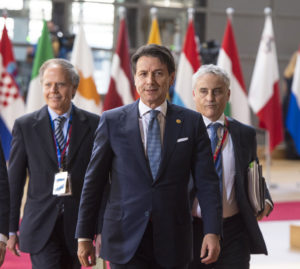
On Thursday June 28, 2018, the EU held a crucial summit on migration. According to DW TV comments, there was no way to overestimate the importance of this “mother of all summits”.
European media indicated the fate of Germany’s current administration heavily depended on the results the Chancellor brought back to the German people. Also, the ultimate existence of the European Union itself was at stake.
DW TV referred to a report from the European Council which allegedly stated, “the number of illegal entries … has fallen by 96%” and said, therefore, the issue was not about numbers. DW TV suggested the crisis was really rooted in something deeper — something it characterized as a power struggle between moderates and the rising right.
Summit Obstacles

At the summit, Italy’s Prime Minister Giuseppe Conte led the opposition
Several Eastern European countries for years have refused to take in more war refugees and asylum seekers. At June’s 2018 EU summit, the new governments of Italy and Austria sided with them.
Back in 2015, one of them, Hungary erected a barb wire fence and instituted its own border crossings to keep refugees out. That was a clear violation of the EU’s Dublin and Schengen agreements. A New York Times 2015 article, “Explaining the rules for borders and asylum”, covered both regulations and the situation.
For other details, read our December 18, 2017 article titled, “Austria and Her Neighbors” and our June 26, 2018 article, “Migration Mutiny”.
After the Summit
A summit agreement was reached on ways to handle new migrants and lessen the burden on gateway countries like Italy and Greece. However, the issue of non-legal migration won’t disappear overnight.
Not only does the agreement depend on more cooperation from yet unnamed nations, in and outside Europe, to work; but it won’t begin to satisfy everybody. Some are unhappy about the number of temporary refugees already in Europe for years with no repatriation day in sight. Significant cultural differences are often cited.
Asylum-seekers continue to risk the journey. Terrorism is still a fear. Trade war is threatening the economic recovery. Current conditions are tailor made for more inroads by the far right.
Photo credits: Flags courtesy of EU Banking Association, License: CC BY-ND 2.0; June EU Summit photo courtesy of the Italian government